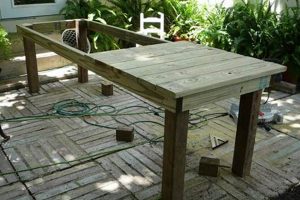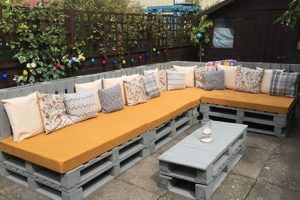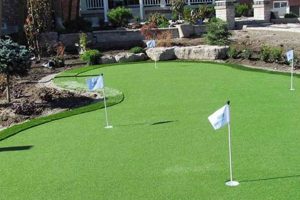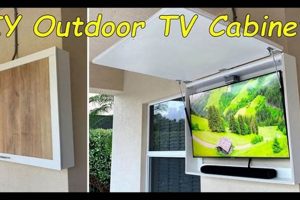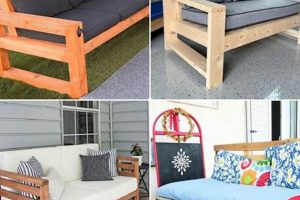The construction of custom receptacles for drought-tolerant plants destined for external environments is a common horticultural activity. This undertaking typically involves selecting suitable containers, preparing appropriate soil mixtures, and arranging various species of plants known for their water-retentive properties. An example would be the creation of a multi-tiered display featuring echeverias, sedums, and sempervivums in a terracotta pot filled with a well-draining cactus mix.
This practice offers several advantages, including enhanced aesthetic appeal of outdoor spaces, opportunities for creative expression, and increased control over plant health through tailored growing conditions. Historically, similar techniques have been employed in arid and semi-arid regions to cultivate ornamentals and edibles with limited water resources, demonstrating resourcefulness and adapting to environmental limitations.
The subsequent discussion will delve into aspects such as material selection for constructing these containers, optimal planting strategies for the chosen plant types, and maintenance protocols to ensure the long-term health and visual appeal of the created arrangement.
Essential Guidelines for Exterior Xerophytic Plant Container Projects
The following recommendations aim to optimize the success and longevity of constructed containers for drought-resistant flora intended for open-air placement. Adherence to these principles will foster healthy growth and visual appeal.
Tip 1: Drainage is Paramount. Ensure adequate drainage holes in the container’s base to prevent waterlogging. Excess moisture leads to root rot, a common cause of plant demise.
Tip 2: Select Appropriate Growing Media. Utilize a well-draining soil mixture specifically formulated for cacti and succulents. Amend standard potting soil with perlite, coarse sand, or pumice to improve aeration and drainage characteristics.
Tip 3: Container Material Matters. Opt for porous materials such as terracotta or unglazed ceramic, which allow for enhanced air circulation around the root system. Avoid dark-colored containers in climates with intense sunlight to prevent excessive soil heating.
Tip 4: Strategic Plant Placement. Consider the mature size and growth habits of each species when arranging the plants within the container. Provide ample spacing to allow for optimal air circulation and light penetration.
Tip 5: Acclimation is Crucial. Gradually introduce newly planted arrangements to direct sunlight to prevent sunburn or shock. Begin with a shaded location and progressively increase sun exposure over a period of one to two weeks.
Tip 6: Monitor Watering Practices. Water thoroughly but infrequently, allowing the soil to dry completely between waterings. Adjust watering frequency based on environmental conditions and seasonal variations.
Tip 7: Protect from Frost. In regions with freezing temperatures, provide protection from frost. This may involve relocating the container to a sheltered location or covering the plants with frost cloth.
Tip 8: Fertilization Considerations. Apply a balanced, water-soluble fertilizer specifically formulated for cacti and succulents sparingly during the growing season. Avoid over-fertilization, which can lead to leggy growth and weakened plants.
Implementing these strategies will yield a thriving and visually captivating display of drought-tolerant species within custom-built containers, enhancing outdoor spaces while minimizing water consumption.
The subsequent section will address common challenges encountered during these projects and offer solutions to ensure long-term success.
1. Drainage Optimization
Drainage optimization constitutes a foundational element in the successful execution of exterior receptacles for xerophytic vegetation. The inherent characteristics of succulents necessitate rapid water removal from the root zone to prevent the onset of anaerobic conditions and subsequent root decay. Insufficient drainage directly correlates with plant morbidity and mortality. Consider, for example, a scenario involving Sedum species planted in a container lacking adequate drainage; the resultant waterlogged soil fosters fungal proliferation, ultimately leading to root rot and plant collapse.
Implementation of effective drainage strategies within these containers mandates a multi-faceted approach. Firstly, the selected container must possess appropriately sized and located drainage apertures to facilitate unimpeded water egress. Secondly, the substrate must exhibit exceptional permeability. Employing a mixture of coarse sand, perlite, and organic matter ensures that water percolates freely through the soil profile, mitigating the risk of water retention. A real-world illustration can be found in large-scale rooftop gardens featuring extensive Sempervivum plantings; these installations invariably incorporate specialized drainage layers to effectively manage stormwater runoff and prevent substrate saturation. The lack thereof leads to catastrophic failure of the planting.
In conclusion, drainage optimization is not merely a desirable attribute but an indispensable requirement for successful construction of xerophytic containers. Neglecting this vital aspect will inevitably compromise plant health, diminish aesthetic value, and necessitate costly remediation efforts. The practical significance of proper drainage is underscored by the observable consequences of its absence, highlighting its role in sustainable and visually appealing outdoor arrangements.
2. Appropriate Soil Selection
The choice of soil medium directly influences the health and longevity of xerophytic plants cultivated in exterior containers. Soil selection is not merely a background consideration; it is a determining factor in the plant’s capacity to thrive in an artificial environment. The success of any project is predicated on the use of soil formulations tailored to the specific needs of these species.
- Drainage Capacity
Xerophytic plants, by nature, exhibit intolerance to waterlogged conditions. The soil must possess exceptional drainage capabilities to prevent root rot. A suitable medium incorporates coarse materials such as perlite, pumice, or gravel, facilitating rapid water percolation and limiting moisture retention. Consider the implications of utilizing standard potting soil, which retains excessive moisture; this often results in fungal infections and compromised root integrity.
- Nutrient Content
The nutrient requirements of xerophytic plants differ significantly from those of traditional garden flora. These plants generally thrive in nutrient-poor environments. A soil medium with excessive nitrogen or phosphorus can lead to weak, etiolated growth. A low-nutrient, mineral-based soil amended with a small amount of slow-release fertilizer is typically recommended.
- pH Level
Soil pH affects nutrient availability and uptake. Most xerophytic plants prefer a slightly acidic to neutral pH range (6.0-7.0). Alkaline soils can inhibit the absorption of essential micronutrients. Soil testing is advisable to determine the pH and amend accordingly, using sulfur to lower the pH or lime to raise it.
- Organic Matter Content
While some organic matter is beneficial for providing structure and water retention, excessive amounts can impede drainage and contribute to fungal growth. A balanced approach is warranted. Aim for a soil composition that is predominantly mineral-based with a small percentage of well-decomposed organic matter, such as composted bark or leaf mold.
The aforementioned facets of soil selection collectively contribute to the overall success. Failure to adhere to these guidelines can compromise plant health, necessitating costly interventions. An informed approach to soil formulation ensures that the xerophytic plants not only survive but flourish, thereby validating the effort invested in the construction of aesthetically pleasing and sustainable outdoor displays.
3. Container Material Choice
Selection of the container medium represents a critical decision point in the creation of custom xerophytic plant displays intended for outdoor environments. The material composition of the chosen container directly influences factors such as drainage, temperature regulation, and overall structural integrity, all of which bear significant implications for plant health and longevity.
- Porosity and Drainage
The porosity of a container material dictates its capacity to facilitate water drainage and air circulation around the root system. Terracotta, for instance, exhibits a relatively high degree of porosity, allowing for superior drainage and reduced risk of waterlogging. Conversely, non-porous materials such as plastic or glazed ceramic retain moisture to a greater extent, potentially leading to anaerobic soil conditions and root rot. The selection of container material should therefore align with the specific moisture requirements of the intended plant species.
- Thermal Properties
Container materials exhibit varying degrees of thermal conductivity, influencing the temperature of the soil and root zone. Dark-colored containers, particularly those made of metal or plastic, absorb solar radiation and can lead to excessive soil heating, potentially damaging delicate root structures. Lighter-colored containers or those constructed from insulating materials such as wood or concrete offer greater protection against temperature extremes. Strategic material selection can mitigate the risk of thermal stress and promote optimal plant growth.
- Durability and Weather Resistance
Exterior containers are subjected to environmental stresses, including temperature fluctuations, precipitation, and ultraviolet radiation. The container material must possess sufficient durability to withstand these conditions without degradation or structural failure. Materials such as concrete, stone, or treated wood offer superior weather resistance compared to more fragile options such as unglazed ceramic or thin-walled plastic. The selection of a durable material ensures the long-term structural integrity and aesthetic appeal of the arrangement.
- Aesthetic Considerations
The visual characteristics of the container material contribute to the overall aesthetic impact of the arrangement. The container should complement the plant species and the surrounding environment. Materials such as terracotta or natural stone offer a rustic and organic aesthetic, while sleek metal or brightly colored plastic can provide a more contemporary look. Careful consideration of aesthetic factors enhances the visual appeal of the display and integrates it seamlessly into the outdoor space.
The foregoing factors underscore the interconnectedness of material selection and the creation of thriving outdoor xerophytic plant displays. A judicious choice of material optimizes drainage, regulates temperature, ensures durability, and enhances aesthetic appeal, ultimately fostering plant health and maximizing the visual impact of the arrangement within the broader landscape.
4. Strategic Plant Arrangement
Strategic plant arrangement is a crucial determinant of success in the implementation of “outdoor succulent planter diy” projects. The arrangement dictates resource allocation, visual appeal, and overall plant health within the confined environment of the container. Improper plant placement can create conditions detrimental to specific species, leading to uneven growth, increased susceptibility to disease, and ultimately, the failure of the aesthetic design. A well-executed arrangement, conversely, fosters a balanced ecosystem within the planter, maximizing available resources and enhancing the visual harmony of the collection. For example, taller specimens positioned centrally can overshadow smaller, light-dependent species if not carefully considered, demonstrating a direct cause-and-effect relationship between arrangement and plant vitality.
The practical significance of strategic plant arrangement extends beyond mere aesthetics. Careful consideration of mature plant size and growth habits is paramount. Species with aggressive growth patterns should be positioned to prevent them from overwhelming more delicate varieties. Color and textural contrasts, when thoughtfully implemented, can create visually striking arrangements that enhance the overall impact of the planter. Furthermore, species with similar watering requirements should be grouped together to simplify maintenance and ensure consistent soil moisture levels throughout the container. The arrangement, therefore, must function as both a visually pleasing composition and a practical strategy for promoting plant health and longevity.
Effective strategic plant arrangement requires a thorough understanding of the individual characteristics of each chosen species. Challenges often arise from a lack of foresight regarding plant growth habits, leading to overcrowding or uneven distribution of resources. Overcoming these challenges necessitates meticulous planning and ongoing observation. By prioritizing plant compatibility, resource allocation, and visual harmony, strategic plant arrangement elevates the “outdoor succulent planter diy” project from a simple gardening activity to a sustainable and aesthetically pleasing horticultural creation.
5. Acclimation Protocols
Acclimation protocols are critical for the successful integration of newly planted xerophytic species into custom-built exterior containers. These protocols mitigate the shock associated with abrupt changes in environmental conditions, ensuring plant survival and facilitating healthy growth. The transition from a controlled nursery environment to the variable conditions of an outdoor setting necessitates a gradual adjustment period.
- Gradual Sun Exposure
Newly planted xerophytes are particularly susceptible to sunburn when abruptly exposed to intense sunlight. Acclimation protocols mandate a gradual increase in sun exposure over a period of several weeks. Initially, the container should be placed in a shaded location, with incremental increases in sun exposure each day. This allows the plants to develop protective pigments and adjust their photosynthetic processes, preventing tissue damage. For example, a newly planted Echeveria should initially receive only indirect sunlight, with gradual exposure to direct morning sun over a two-week period.
- Temperature Regulation
Abrupt temperature fluctuations can stress newly planted xerophytes, hindering root establishment and overall growth. Acclimation protocols involve protecting the plants from extreme temperature swings, particularly during the initial weeks after planting. This may involve relocating the container to a sheltered location during periods of intense heat or cold, or providing temporary shade during the hottest part of the day. Species such as Sedum can be particularly vulnerable to temperature shock, necessitating careful monitoring and protection.
- Watering Adjustments
Watering requirements may change significantly as plants transition from a nursery environment to an outdoor container. Acclimation protocols involve careful monitoring of soil moisture levels and adjusting watering frequency accordingly. Overwatering can lead to root rot, while underwatering can cause desiccation. During the initial acclimation period, it is crucial to allow the soil to dry thoroughly between waterings and to adjust watering frequency based on environmental conditions and plant response. This ensures optimal root development and prevents moisture-related stress.
- Pest and Disease Monitoring
Newly planted xerophytes are often more susceptible to pest infestations and disease outbreaks due to the stress associated with transplanting. Acclimation protocols include regular monitoring for signs of pests or disease, such as aphids, mealybugs, or fungal infections. Early detection and treatment can prevent widespread problems and ensure plant health. Implementing preventative measures, such as applying insecticidal soap or fungicide, may be necessary during the acclimation period to protect vulnerable plants.
The successful implementation of acclimation protocols is essential for optimizing the long-term health and aesthetic appeal of xerophytic plants in outdoor containers. These protocols, encompassing gradual sun exposure, temperature regulation, watering adjustments, and pest monitoring, collectively contribute to the plant’s ability to adapt to its new environment and thrive in the container setting. Neglecting these protocols can compromise plant health and diminish the overall success of the project.
6. Watering Management
Effective watering management represents a pivotal determinant of success in the context of outdoor succulent container construction. Succulents, characterized by their inherent drought tolerance, necessitate meticulous control over irrigation practices. Overwatering induces root rot, a primary cause of plant morbidity and mortality within container environments. Conversely, insufficient hydration leads to desiccation and stunted growth. The balance between these extremes is contingent upon factors such as plant species, substrate composition, container material, and prevailing climatic conditions. For instance, Echeveria species planted in terracotta pots during periods of high humidity require significantly less frequent watering than those in plastic containers exposed to direct sunlight.
Successful watering management strategies encompass several key elements. First, visual inspection of the substrate surface provides an initial indicator of moisture levels. However, this is often insufficient. Substrate moisture probes offer a more accurate assessment of hydration status, particularly in deeper containers. Second, consideration must be given to the specific water retention properties of the chosen substrate. Highly porous mixtures, such as those amended with perlite or pumice, drain rapidly and necessitate more frequent irrigation. Third, ambient temperature and humidity exert a profound influence on evapotranspiration rates. Watering frequency should be adjusted seasonally to account for these fluctuations. Furthermore, proper drainage is essential; containers must possess adequate drainage apertures to prevent water accumulation at the base.
In conclusion, effective watering management is not merely a peripheral consideration but an indispensable component of outdoor succulent container cultivation. Failure to adhere to appropriate watering protocols inevitably compromises plant health and diminishes the overall aesthetic appeal of the arrangement. A nuanced understanding of plant physiology, substrate characteristics, and environmental factors is paramount to achieving sustained success. Mastering these principles elevates the practice from simple gardening to a sustainable and visually compelling horticultural endeavor. Proper execution of watering management minimizes plant loss, enhances visual appeal and ensures the long-term viability of the container ecosystem.
7. Frost Protection
The implementation of adequate frost protection measures is fundamentally linked to the long-term viability of outdoor succulent planter constructions in regions subject to sub-freezing temperatures. Succulent species, adapted to arid and semi-arid climates, generally exhibit limited tolerance to prolonged exposure to freezing conditions. Without appropriate safeguards, cellular damage, tissue necrosis, and ultimately plant demise can occur.
- Cellular Damage Mitigation
Freezing temperatures induce the formation of ice crystals within plant cells, leading to cellular rupture and subsequent tissue damage. Protective measures aim to prevent or minimize intracellular ice formation. Strategies include selecting cold-hardy succulent species, employing insulating container materials, and providing temporary shelter during frost events. For example, encasing a terracotta container in burlap provides an insulating barrier, slowing the rate of heat loss and reducing the risk of cellular damage.
- Root Zone Insulation
The root system of succulents is particularly vulnerable to freezing damage due to its proximity to the soil surface. Insulating the root zone is crucial for maintaining plant health. Mulching with organic materials such as straw or wood chips provides a protective layer, slowing the rate of heat loss from the soil. Additionally, elevating the container off the ground prevents direct contact with the frozen surface, further insulating the roots. The efficacy of this method is demonstrated by the widespread use of elevated garden beds in regions prone to frost.
- Environmental Sheltering
Providing temporary shelter during frost events can significantly reduce the risk of cold damage. Moving containers to a sheltered location, such as a garage, greenhouse, or covered patio, shields the plants from direct exposure to freezing temperatures and wind. Alternatively, covering the plants with frost cloth or horticultural fleece provides a protective barrier, trapping heat and preventing ice formation on plant surfaces. Such preventative steps can be the difference between a thriving or decimated arrangement after even a short period of cold weather.
- Water Management Considerations
Soil moisture content influences the rate of heat loss and the susceptibility to freezing damage. Saturated soil freezes more readily than dry soil, exacerbating the risk of cellular rupture. Proper water management entails reducing watering frequency in anticipation of frost events to allow the soil to dry partially. Additionally, ensuring adequate drainage prevents water accumulation at the base of the container, minimizing the potential for root zone freezing. For instance, ceasing watering several days before a forecasted frost can dramatically reduce the risk of damage.
The integration of these frost protection measures into the planning and execution of outdoor succulent planter construction ensures the long-term survival and aesthetic appeal of these arrangements in regions subject to freezing temperatures. Failure to address frost protection can result in significant plant losses and undermine the overall sustainability of the project. Careful consideration of these elements is therefore essential for responsible and effective cultivation of succulents in outdoor container environments.
Frequently Asked Questions
The following questions address common inquiries and misconceptions regarding the establishment and maintenance of drought-resistant plant arrangements in outdoor containers.
Question 1: What constitutes a suitable container material for outdoor xerophytic plant displays?
Container materials should prioritize drainage and thermal regulation. Terracotta and unglazed ceramic offer superior drainage compared to plastic. Light-colored containers are recommended to mitigate excessive soil heating. Durability in varying weather conditions is also a crucial factor.
Question 2: How frequently should outdoor succulent planters be watered?
Watering frequency is contingent upon environmental factors and plant species. The soil should be allowed to dry completely between watering cycles. Overwatering is a primary cause of root rot. Visual inspection and substrate moisture probes can aid in determining hydration needs.
Question 3: Is fertilization necessary for succulents in outdoor containers?
Fertilization should be approached cautiously. Over-fertilization can lead to weak growth. A balanced, water-soluble fertilizer formulated for cacti and succulents should be applied sparingly during the growing season, typically spring and summer.
Question 4: What measures are required to protect outdoor succulent planters from frost?
Frost protection strategies include relocating containers to sheltered locations, insulating the root zone with mulch, and covering plants with frost cloth. Cold-hardy succulent species should be selected for regions with freezing temperatures. Prevention of ice formation within plant tissues is the primary objective.
Question 5: How can root rot be prevented in outdoor succulent planters?
Prevention of root rot hinges upon adequate drainage, appropriate soil selection, and judicious watering practices. Ensure containers have sufficient drainage holes, utilize a well-draining soil mixture, and avoid overwatering. Regular inspection of plant roots is recommended.
Question 6: How does one determine the appropriate spacing between succulents in a container arrangement?
Spacing should accommodate the mature size and growth habits of each species. Overcrowding can impede air circulation and increase susceptibility to disease. Allow adequate spacing to prevent competition for resources and promote optimal growth.
These responses provide a framework for informed decision-making in the design, construction, and maintenance of thriving exterior xerophytic plant displays. Careful consideration of these factors enhances the long-term health and aesthetic appeal of the arrangement.
The subsequent discussion will address troubleshooting common issues encountered in these projects and provide practical solutions.
Conclusion
This examination of outdoor succulent planter DIY has underscored the crucial considerations for crafting thriving displays. From drainage optimization and appropriate soil selection to strategic plant arrangement and frost protection, each element plays a significant role in the long-term success of such projects. Adhering to informed practices minimizes plant loss, maximizes aesthetic appeal, and promotes sustainable horticultural endeavors.
The information provided serves as a foundation for responsible and effective cultivation of succulents in outdoor container environments. Continued learning and adaptation based on individual plant responses and local climatic conditions will further enhance project outcomes. Successfully executing “outdoor succulent planter diy” requires knowledge application and commitment, resulting in visually appealing, drought-tolerant installations. This will benefit owners in water conservation and creating sustainable gardens.


